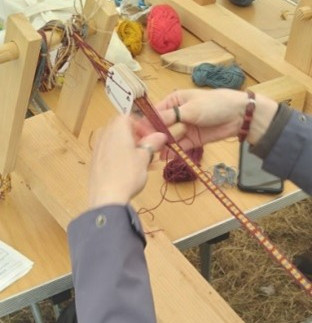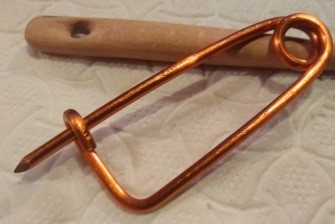Historical Craeft Course
- May 24, 2024
- 5 min read
I’m a SHARP newbie, I came as a BERT in 2022 and loved it. I adored my hole in the ground and the overarching story of the site and how it came to be and its place in the landscape so when help was needed I was happy to get involved.
2023 was the first year of the Craefts course and despite the weather it was great fun and gave me the first opportunity to share the skills our ancestors had mastery of in the past.
Coming from an arts, rather than an archaeological, background I took on the task of learning a lot of new skills myself, while developing ones I already had but with a historical twist, which was an incredibly fascinating journey and left me with a great respect for those who came before, as the amount of time things take is almost incomprehensible. It’s a long way from the nettle to the cloth! Luckily with the advent of YouTube, learning skills can be a little quicker these days and having found the wonderful Sally Pointer she became my go to for new skills as she covers a fantastic rage of different techniques and is a great teacher.
We chose to focus on the basics; pottery, fibre work, bone, and antler and metal work, and due to the one resource we are short of – time – we did use some modern tools though we are collecting a range of reproduction ones to compliment the tool store.
The first job was to restore the hearth from last year which had degraded somewhat but with a supply of horse dung from down the track, some fire clay and sand we mixed up a wheelbarrow full and remade the pit to accommodate the bellows and even added a dragon, lizard and, of course, the obligatory duck.
Before and after pictures of the fire pit used for casting and spending an evening or two of music around |
After a quick introduction to the site and a trench tour, we began the week with pottery work as we needed time for these to dry before trying to fire them. Sadly the weather was against us and the firing was not a great success but gave us some great reproduction pot sherds! Thankfully this year we have the expertise of Karen who is joining us, she is a very experienced potter and has been producing a range of Anglo Saxon and Viking pottery based on finds from the local area.
Last year we made a few pots using pinch and coil methods leaving them to dry before moving onto bone and antler working – ideally this would have been first as finds wise it would come before pottery but see above. Bone and antler would have been easily available and used for a range of things and we focussed on making a needle each. Whilst using the authentic Anglo Saxon saw was a challenge and would take a deal of time we found the Iron Age knives were perfect for shaping the needles and scoring the eye hole and we all managed at least one needle each.
Final image here shows bone & antler needles showing the slice from the end of the antler |
We then moved onto fibre production and this is the bit that really makes you appreciate your ancestors. With the knowledge that each piece of cloth, each item of clothing began as a plant or animal fibre which had to be processed and then spun and woven, again taking a huge amount of time. We take another shortcut here and have available fibres and yarn in wool, flax, hemp and linen which whilst we can get a taste of the process behind producing textiles mean we don’t have to spend a week preparing enough nettle for a short piece of string. Again Sally Pointers website has fibres available and we have plenty to try out the very therapeutic technique of cord making, even sitting in the church lecture hall listening and cording at the same time. Using flax I began to think that this would be a good drizzly day activity as flax needs an amount of dampness and would our ancestors have used these otherwise grey days to their advantage?
Creating the white fibres from nettles using a modern day knife; We will also try flint scrapers and Iron Age knives this year as well as having some lime bast to have a go with |
The next stage of fibre production is weaving and one of the earliest forms being sprang which is using just the warp fibres to produce a very stretchy open weave. We also had a go at tablet weaving which has been made across the world using small tablets with holes to produce various patterns by the ways of threading and turning. It felt very much like they would have had to have songs or some way of keeping track of the patterns as they are quite complex and easy to mess up when distracted! Having tried various loom designs the easiest one was most definitely the large loom (loosely) based on the one found in the Viking ship burial at Oseberg which contained the remains of two women and a variety of weaving tools and woven pieces. Two bits of 2x1 and a couple of broom handles sufficed to make a very serviceable loom.
Early experiments in tablet weaving on different looms |


The group then tried their hand at wire working, led by Richard who helped the group make bangles based on methods used to make torcs using twisting in alternate directions, similar to the way cordage is made but with the added difficulty of it being wire, we had managed to source a small amount of bronze wire to work with the copper and the hardness of this made it a little trickier but everyone managed to produce a torc bangle. We also had a go at making pennanular brooches and a safety pin based on the one found at Sedgeford.
A selection of wire items including rings and pins |
We then came on to metal work casting, again using the quicker method of pewter and utilising cuttlefish to carve the designs into a ready-made mould to pour in the molten metal and wait for it to cool to see if the mould had worked, this can be quite addictive with people making multiple items during the day
We left the final day free to enable everyone to finish their projects, have another go at some of the techniques and show the rest of the site what we had been doing. All in all, despite the weather, a really great week and a good start for the course.
In 2024 we will be working with potter Karen making beads and pots, having a chance to work some amber and jet to make simple jewellery; trying out lime bast cordage and using flint scrapers to process the local nettles; we have some natural paints to try out and possibly a bit of natural dyeing, time and weather permitting. We may or may not get time to try a small pit firing again but we will generally be having a good old time pretending to be our ancestors with the added advantage of a nearby kettle to provide us with cups of tea and a great catering team to feed us negating the need to go and forage or hunt for our lunch!
In the future we are looking at a second week which would be more experimental with a larger project and the option of people being able to book along the same lines as the volunteer experiences, at a lower cost. This will give us the chance to develop longer term ideas and try some experimental loom making, kiln building, forging, wattle and daubing, flint knapping and who knows what else, we might even be able to build a mini malting kiln and an tiny Anglo Saxon house! How it evolves will be a democratic affair and it will be a place to share skills and learn new ones; to ask questions then see if we can figure out the answers, a place for discussion and for quiet contemplation.
If you are interested in joining us to learn about these fascinating historical craefts, you can book our Historical Craeft and Skills course for 2024 here. We would love to see you there!
Sam Atkins
May 2024

























































































Comments